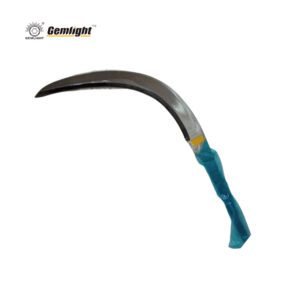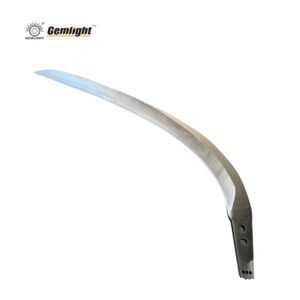1. Understanding the Cutlass Machete: History, Function & Design
The cutlass machete is more than just a tool — it’s a cultural icon across agricultural economies. With deep roots in West Africa, the Caribbean, and parts of Latin America, the cutlass machete has long served farmers, field workers, and landowners as a primary cutting instrument.
Unlike standard straight machetes, the cutlass machete typically features a slightly curved blade, often wider at the tip. This design delivers more power in each swing, making it ideal for cutting through dense vegetation, clearing bush, and harvesting crops like sugarcane and cassava. The blade length usually ranges between 16 and 22 inches, offering a balance between reach and control.
The handle is traditionally made from hardwood or polypropylene, secured with rivets or full tang construction for long-term durability. Workers appreciate the ergonomic grip, especially during full-day field operations.
In recent decades, cutlass machetes have evolved from handmade local versions to precision-manufactured tools from steel factories in China. These modern cutlasses feature quenching and tempering treatments, ensuring the blade has the right mix of hardness and flexibility.
The cutlass is also recognized in the education and defense sectors of some countries, used symbolically and practically. However, its primary role remains agricultural.
For any buyer targeting African or Caribbean markets, understanding the heritage and preferred use of the cutlass machete is critical. This insight helps you source models that align with local habits—and maximize sales.

2. Cutlass vs Machete: What Is the Real Difference Today?
One of the most common questions in the agricultural machete tools market is:
“What is the difference between cutlass vs machete?”
While both tools serve similar purposes, the differences matter—especially for B2B buyers.
Blade Design
The machete generally has a straight, uniform blade. It’s available in multiple types such as Latin-style, Bolo, Panga, and Kukri. In contrast, the cutlass machete typically has a slightly curved blade, with more weight focused toward the tip. This makes it better suited for chopping through thick vegetation with momentum.
Use Case
Standard machetes are widely used for general land clearing, forest work, and jungle survival. However, cutlass machetes dominate in crop-oriented work, particularly in West Africa. Farmers favor the cutlass for weeding, harvesting, and clearing narrow rows of plants.
Length & Weight
A cutlass machete often has a shorter but thicker blade. The heavier tip enhances cutting power but may reduce speed. Standard machetes vary widely—from lightweight Latin styles to heavy-duty Kukri types—offering more diversity for specific uses.
Market Preference
In Ghana, Nigeria, and Cameroon, the word “machete” is often used interchangeably with “cutlass,” but locals expect the cutlass-style design. In Central and South America, however, straight machetes are preferred.
Understanding the difference between cutlass and machete helps wholesalers avoid mismatched inventory. If you’re distributing in West Africa, shipping Latin machetes may lead to slow sales. The right choice can mean the difference between strong demand—or total rejection.
In short, for B2B buyers, it’s not about which is better—it’s about knowing which tool your customers are asking for.

3. Cutlass Machete Product Line from Gemlight: Built for Tough Use
At Gemlight, we don’t just manufacture machetes—we craft field-tested cutlass machete solutions built for hard agricultural work. With decades of manufacturing expertise, we supply high-carbon steel machetes to distributors, brand owners, and agricultural wholesalers worldwide.
Blade Quality
Our cutlass machetes feature heat-treated blades made from high-carbon steel. The blades are quenched and tempered for durability, allowing them to resist breaking under high stress. Each blade is fully polished and sharpened by machine and hand to ensure precision cutting.
Handle Options
We offer both hardwood and plastic handles, secured with steel rivets. Buyers can choose ergonomic handle shapes designed for wet environments, high grip, and reduced fatigue. Our full-tang design improves balance and safety, especially for end users working long hours.
Cutlass types of machete
Our bestselling cutlass models include:
Ghana-Style Cutlass: Curved blade, hardwood handle, 18–22 inch length
Cameroon-Style Cutlass: Longer blade, wider front, plastic handle
Custom-Made Cutlass: Based on buyer samples or design specs
OEM and Branding Services
Gemlight supports OEM, ODM, and private-label projects. We can:
Etch your logo on the blade
Apply custom handle colors
Design branded packaging for retail
Support SGS inspection, CO, and Form A/E documents
Logistics & Export
With 4 production lines, we offer a fast lead time and flexible MOQ. Whether you need 10,000 pcs or a 20-foot container mix with hoes, rakes, or sickles—we deliver. Our export team is experienced in shipping to Africa and Latin America, with full document prep and customs coordination.
If you’re sourcing cutlass machetes for your market, Gemlight offers the tools, quality, and support to make your imports fast, efficient, and profitable.

4. Choosing Between Cutlass vs Machete: What Buyers Should Consider
When deciding whether to import cutlass machetes or standard machetes, B2B buyers should think beyond just the product itself. The market context, user habits, and intended application all matter.
Know Your Market
In West Africa, “cutlass” is not just a tool—it’s a daily necessity for farmers. Importing Latin or straight machetes to these markets often fails unless local usage justifies it. In contrast, Central and South American markets are more flexible in blade shape preference.
End-User Needs
If your customers are clearing thick underbrush or performing survival work, tactical or straight machetes may be better. But for farming, weeding, or harvesting? Cutlass-style blades outperform due to their shape and cutting dynamics.
Factory Support
Not all suppliers can provide both styles. At Gemlight, we understand the full spectrum of buyer needs. Our team helps select the best models based on region, usage, and even seasonal demand patterns.
MOQ, Samples, Lead Time
Start with a sample order of cutlass machetes and get feedback from your market. We offer low MOQ for testing and fast production for scale-up. Lead time typically ranges from 25–35 days depending on quantity and customization.
Because cutlass machetes are high-volume, fast-moving tools, sourcing them from a direct factory gives you better margins. You avoid trader markups and ensure product consistency across shipments.
In conclusion, choosing between cutlass vs machete isn’t a product decision—it’s a market strategy. Let your customer habits guide your product line, and let a factory like Gemlight handle the rest.

About us:
Dingzhou Gemlight Cutting Tools Co., Ltd.,With a solid foundation since 1990, Gemlight machete is a trusted name in the field of cane machete manufacturing. We focus on R&D, design and production to produce high quality wholesale china machete and shovel,hoe,pickaxe,sickle,farm tools.
Gemlight Machete factory Based in Baoding, Hebei, China, we benefit from efficient logistics and fast delivery. Our products have been well received in more than 50 countries, thanks to our commitment to customer satisfaction








